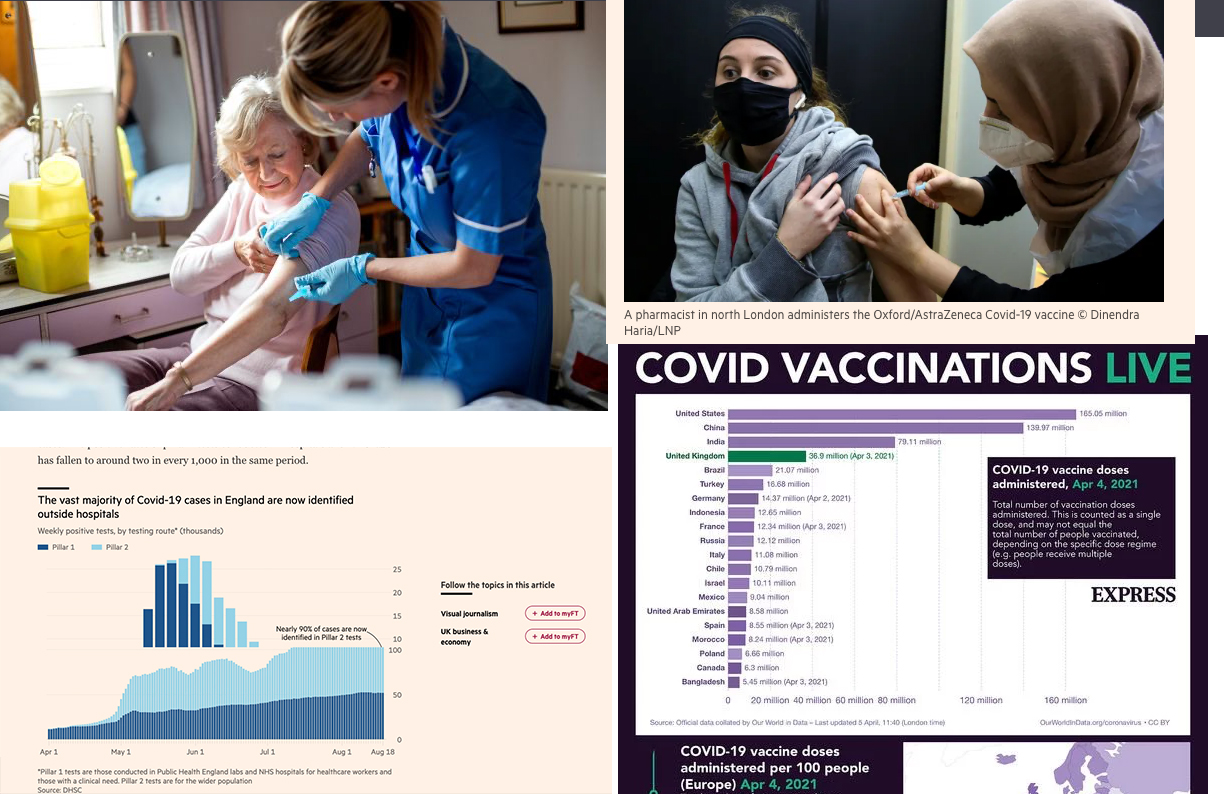Out now: New article in IJCS on generic visuals of Covid-19 in the news
by Giorgia Aiello :
The first publication from Generic Visuals in the News is now out in the International Journal of Cultural Studies. The article is open access and has been published in its OnlineFirst version. It will be soon included in the IJCS special issue “Covid-19: The cultural constructions of a global crisis”, to be co-edited by Myria Georgiou and Paul Frosh. We collected data for this article between December 2020 and May 2021. This also means that we developed this article in the midst of the pandemic, with all related challenges and losses, so we are especially happy to see this article in print.
Our analysis is based on a sample of visuals which appeared in UK news during major moments in the Covid-19 crisis: at the height of the second wave against the backdrop of Brexit, and during the UK's effective rollout of mass vaccinations. We drew our data from our three partner organizations, namely The Financial Times, the BBC and a range of Reach publications.

The NHS as a framework for national belonging: photos of vaccination in the UK from The Mirror (14 December 2020) and The Financial Times (7 April 2021) and visual representations of UK data about vaccination and Covid-19 cases from The Financial Times (1 December 2020) and The Express (6 April 2021).
In the article, we do four main things.
First, we argue that we need to explore the communicative work that generic visuals do during events like the Covid-19 crisis. Specifically, we explain why stock photos and simple data visualizations should be studied together under this label. In doing so, we point out that news organizations often use these two different types of visuals together, and that they use them in both similar and different ways. For example, both stock photos and data visualizations are increasingly used as standardized design elements in the layout of news articles. This said, data visualizations are still often mobilised as trustworthy or ‘factual’ representations of different types of information, whereas stock photography is largely used to illustrate general concepts and even clichés.
Second, we mobilize Michael Billig’s concept of ‘banal nationalism’ and argue that different types of generic visuals of Covid-19 promote banal visions and versions of nationalism, localism and cosmopolitanism in the face of the crisis, in different but connected ways. This is a notion that has been typically used to examine symbols and words that both routinely and unobtrusively ‘mark’ national belonging. We argue that generic visuals of Covid-19 in the news work in a similar way, fostering forms of ‘banal belonging’ that are subtle but observable.
Third, we explain that these generic visuals ‘work’ through symbolic reiteration, or the performative repetition and resignification of a range of visual resources across news stories and other sources. Unlike iconic visuals, generic visuals are not memorable and immediately recognizable as visuals in their own right. Generic visuals do not demand attention and invite recollection, as they do not channel culturally meaningful issues and historically significant events into one or few particular aesthetic forms. Instead, generic visuals of Covid-19 in the news reaffirm unspoken claims and even burgeoning values through a variety of largely unremarkable rhetorical cues across a high volume of imagery – flags, maps, vaccine vials, bar charts, healthcare staff at work, everyday life locales and activities, rising and falling lines.
Fourth, we argue that, by invoking the nation, generic visuals of Covid-19 foreground the role of the state in grappling with the crisis, in ways made possible by their symbolic reiteration. Our sample revealed that, in addition to perhaps unsurprising markers of national identity, some visuals pointed to an imagined community assembled through the state, rather than through the everyday cultural markers that we have come to associate with ‘Britishness’. For example, both stock images and data visualizations of the UK’s vaccination programme foregrounded a united (though fairly homogeneous) picture of the role of a state institution, the NHS, which visually came to stand in for the UK as a rhetorical nation and as a key framework for belonging together in the midst of the crisis.
As Paolo Gerbaudo has recently argued, the global crisis brought about by the pandemic may have been a catalyst for a large-scale ideological shift from neoliberalism to ‘neo-statism’. Our analysis reveals the ambient visual background within which such processes are taking place. The forms of banal belonging represented in the generic visuals that populate the daily news reinforce state power, however unacknowledged and unnoticed. For this reason alone, these often-overlooked visuals are objects worthy of study.
Overall, the article makes important contributions in these four areas. We also believe that this is the beginning of a theory of visual genericity, starting from our definition of symbolic reiteration and our choice to examine stock photos and simple data visualizations together.
